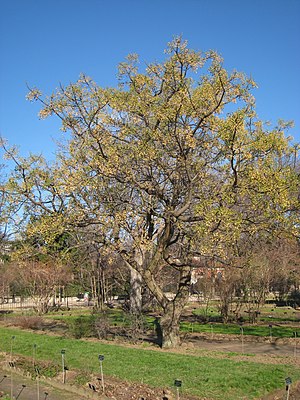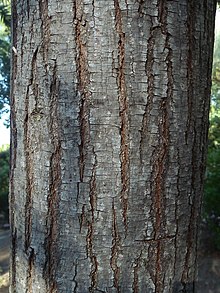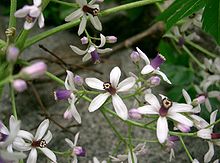Cedar tree
| Cedar tree | ||||||||||||
|---|---|---|---|---|---|---|---|---|---|---|---|---|

Cedar tree ( Melia azedarach ) |
||||||||||||
| Systematics | ||||||||||||
|
||||||||||||
| Scientific name | ||||||||||||
| Melia azedarach | ||||||||||||
| L. |
The cedar tree or Indian cedar tree ( Melia azedarach ), also called Persian lilac , Chinese elder or paternoster tree, is a species of the Melia genus in the mahogany family (Meliaceae). It is a deciduous tree from the south and southeast of Asia and Australia .
description

Vegetative characteristics
The cedar tree is a small to medium-sized deciduous tree that reaches heights of growth of 6 to 15 meters, in China also up to 20 meters and a chest height diameter of 30 to 60 centimeters. In India a maximum trunk diameter of 84 centimeters was measured and in Hawaii a height of almost 23 meters. In Australia it reaches even higher heights.
The trunk is short and the crown broad, rounded and densely branched. Older specimens have a red-brown or dark brown, more or less cracked trunk bark . Characteristic are bulbous growths at the base of older stems and intensive root suckers formation. It makes a slightly pronounced taproot with many rapidly growing and strong lateral roots.
The wood has a narrow, yellowish white sapwood and a light brown to reddish brown core . The annual rings are clearly visible and are up to 3 centimeters wide.
The bark of the branches is initially green and covered with star hair and later becomes almost bare or bare as well as reddish-brown with numerous cork pores ( lenticels ). Inner layers of bark are yellow-brown in color.
The alternate arranged at the branch leaves are divided into petiole and leaf blade. The petiole is relatively long. The leaf blade is doubly unpaired and partly tripinnate. The leaflets are in large numbers in pairs on the approximately 8 cm long leaf axes of the second order. The leaflets are short stalked. The bald and thin leaflet is 2.5 to 6.5 centimeters long and 1.5 to 3 centimeters wide and is ovoid to lanceolate, the tip of the leaf is pointed to tail, the base is rounded to wedge-shaped. The edge is more or less serrated, the leaflets are rarely entire. The upper side of the leaf is dark green and the underside is usually a little lighter. From the midrib, there are 12 to 16 side ribs on each side. When rubbed, the leaves give off a pungent odor. The leaves are shed at the beginning of winter. They usually sprout again in March, shortly before flowering.
Generative characteristics
The cedar tree blooms for the first time after three to four years. The flowering period extends from March to May. Many flowers are loosely arranged in lateral, 10 to 25 centimeters long paniculate inflorescences . The flower stalks are relatively thin.
The pleasantly fragrant flowers are radial symmetry and five-fold with a double flower envelope . The flowers are about 10 millimeters long and 15 to 19 millimeters wide. The five greenish sepals are about 1.5 millimeters long. The five white, light purple or lilac to slightly purple petals are about 10 millimeters long and bent back at the edge. The stamens of the ten to twelve stamens are fused together to form an 8 millimeter long, narrow, purple tube and the upright anthers are arrow-shaped. The on a discus standing, upper permanent stamp is pale green, and is composed of a three to sechskammerigen ovary , a long stylus and a three- to six-lobe scar .
The poisonous and yellowish-beige, round drupes when ripe are somewhat leathery, partly furrowed and about 14-18 millimeters in size. They contain a hard, ribbed stone core with a longitudinally central hole, with four to five dark brown to black, 8 millimeter long, flat seeds. They have a thousand grain mass of 550 to 930 grams. The fruits ripen in September and October and remain on the tree throughout the winter ( hibernation ), where they can often remain until the next bloom.
The number of chromosomes is 2n = 28.
development
The germination takes place epigeously, three to four seedlings develop per stone core. The seedlings have two succulent , elongated cotyledons with a length of 9 to 14 millimeters. The primary leaves are opposite or almost opposite and are initially three-lobed. Only the following leaves are pinnate and alternate. In the first year the seedlings reach a maximum height of about 25 centimeters, in the second year under natural conditions a stature height of 90 centimeters. When cared for, they can reach a height of 1.5 to 2.4 meters in the second year.
Distribution and location requirements
The natural range of Melia azedarach is South and Southeast Asia , although the boundaries are not known. The cedar tree is found in India and Myanmar . In China it occurs frequently in the flat and hill country south of the Yellow River , furthermore in the provinces of Hebei , Hainan , Yunnan , Gansu , in eastern Sichuan . Melia azedarach comes to Taiwan . In the Himalayas , Melia azedarach grows up to altitudes of 2000 meters. There are other occurrences in Japan , Sri Lanka , Nepal , Thailand , Vietnam , Indonesia , Papua New Guinea , the Philippines , Australia and the Solomon Islands . It was introduced in Europe, Africa, the United States, Mexico, tropical South America, the West Indies, and the Galapagos . In the USA it is often overgrown from culture in Texas and Florida to Oklahoma and Southeast Virginia . In Hawaii it is cultivated at altitudes of 2750 meters.
The cedar tree thrives best in a warm and humid climate and as a young tree is sensitive to drought, winter cold and shade. However, older trees in the USA could withstand degrees of cold from −8 to −18 ° C. Its natural area extends over areas with an annual rainfall of 600 to 1000 millimeters. It grows on acidic and neutral soils , but also tolerates alkaline soils with a salinity of up to 0.46%.
ecology
The most common insect pests are spider mites and lice . The mite species Phyllocoptruta oleivora sucks on leaves and disrupts the growth of the cedar tree. Several types of fungus can also cause damage, for example Phyllactinia guttata causes mildew-like damage. Nectria galligena causes a tree canker called target canker. Fomes meliae from the genus of the tinder sponges attacks the wood and destroys it.
Taxonomy
The first publication of Melia azedarach was in 1753 by Carl von Linné . The epithet azedarach is derived from the Persian 'azad dirakht "which means" magnificent tree "means. Another interpretation is based on a derivation from the Latin word “cedrus”, the cedar, which has the fragrant wood in common with the cedar tree.
Ingredients and toxicity
All parts of the plant are classified as poisonous, especially the fruits. The main active ingredients of the bark are saponins , bitter substances such as mangrovin , catechin , vanillic acid , 0.02% essential oils , about 0.04% alkaloids , including azaridin and paraisin, and tetracyclic triterpenes such as kulinone, kulactone and kulolactone. The fruits contain the triterpenes Melianon and Meliantriol, which have a repellent effect on grasshoppers, as well as toxic bitter substances such as Bakayanin.
Poisoning occurs mainly after excessive consumption of the fruit. Symptoms include nausea, vomiting, diarrhea, severe thirst, cold sweats, and cramps. In extreme cases, eating six to eight fruits is said to be fatal. There have also been deaths in pigs and goats, cattle and birds seem to be hardly harmed, and the berries have a narcotic effect on songbirds.
use
Because of its beautiful flowers and bright yellow fruits, it is a popular ornamental wood and is cultivated in many warm, temperate to tropical regions of the world. Since it is easily overgrown, its original range is uncertain. It owes its name "paternoster tree " to the fact that rosaries are made from its stone cores , a tradition that began in southern European monasteries. They are also used to make jewelry chains. Since the seeds in it are poisonous, children are particularly at risk.
The cedar tree is of the greatest importance as a shady park and street tree cultivated worldwide and as an ornamental wood, whereby it is planted as a single tree or in small groups.
The heartwood is durable and easy to work with. Furniture, toys, boxes, agricultural implements and tool handles are made from the wood. The wood is also used as firewood and in India for paper production.
The seeds contain up to 42% oil, which is used as a lubricant and for making paints and soaps. The bark contains 7% tannins , which are obtained together with other ingredients (chuanliansa, kulactone, methylculonate and julolactone). Leaves and dried fruits have insecticidal properties and are used to protect stored textiles .
literature
- Schütt, Weisgerber, Schuck, Lang, Stimm, Roloff: Encyclopedia of Deciduous Trees . Nikol, Hamburg 2006, ISBN 3-937872-39-6 , pp. 327-332 .
- Margot Spohn, Roland Sophn: Kosmos Tree Guide Europe . 680 trees, 2600 drawings. Franckh-Kosmos Verlags-Gmbh & Co. KG, Stuttgart 2014, ISBN 978-3-440-14647-7 , p. 164 ( GoogleBooks ).
Web links
- Paternoster tree at Baumkunde.
- Melia azedarach at CABI Invasive Species Compendium.
- Melia azedarach (PDF file; 82 kB), Florida Exotic Pest Plant Council: FLEPPC.
- Melia azedarach NC State Univ.
- Melia azedarach at IUCN / SSC Invasive Species Specialist Group (ISSG).
- Melia azederach at University of Florida, Institute of Food and Agricultural Sciences.
Individual evidence
- ↑ a b c d e f Schütt et al .: Trees of the tropics. P. 328.
- ↑ a b c d e f Schütt et al .: Trees of the tropics. P. 330.
- ↑ a b c d e Schütt et al .: Trees of the tropics. P. 329.
- ↑ Hua Peng, David J. Mabberley: Melia Linnaeus. , In: Wu Zheng-yi, Peter H. Raven, Deyuan Hong (Eds.): Flora of China , Volume 11 - Oxalidaceae through Aceraceae , Science Press and Missouri Botanical Garden Press, Beijing and St. Louis, 2008, ISBN 978- 1-930723-73-3 : Melia azedarach Linnaeus. , P. 130 - online with the same text as the printed work .
- ↑ Melia azedarach at Tropicos.org. In: IPCN Chromosome Reports . Missouri Botanical Garden, St. Louis
- ^ A b Melia azedarach in the Germplasm Resources Information Network (GRIN), USDA , ARS , National Genetic Resources Program. National Germplasm Resources Laboratory, Beltsville, Maryland. Retrieved July 4, 2009.
- ↑ Helmut Genaust: Etymological dictionary of botanical plant names. 3rd, completely revised and expanded edition. Nikol, Hamburg 2005, ISBN 3-937872-16-7 , pp. 89-90 (reprint from 1996).
- ↑ a b c d Roth, Daunderer, Kormann: Poisonous plants, plant poisons . 4th edition. Nikol, Hamburg 1994, ISBN 3-933203-31-7 , pp. 491 .
- ↑ a b Schütt et al .: Trees of the tropics. P. 332.
- ↑ a b c d Schütt et al .: Trees of the tropics. P. 331.


